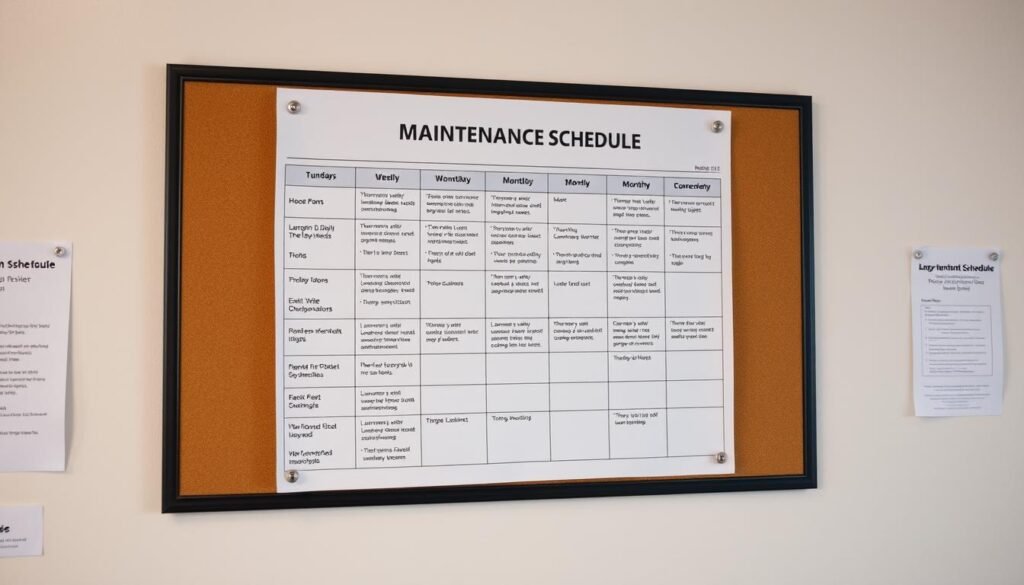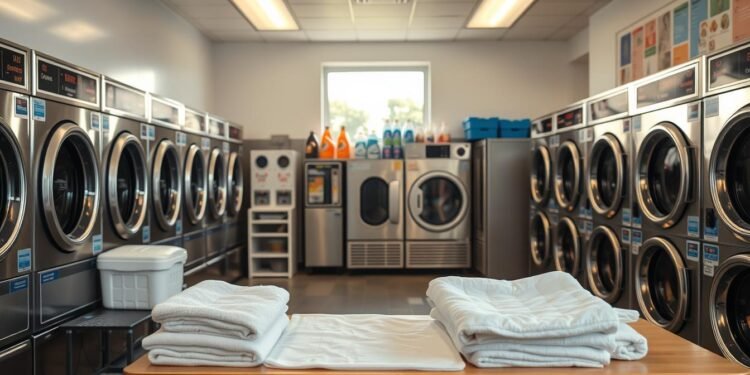Ever wondered why laundromats remain profitable even during economic downturns? These cash-flow-friendly ventures thrive on steady demand, making them resilient against market fluctuations. With profit margins averaging 20-35%, they offer a compelling opportunity for entrepreneurs.
Location plays a crucial role in success. Areas with high population density, limited in-home laundry access, or favorable climates like Florida create ideal conditions. Demographic research helps identify neighborhoods with the strongest need for these services.
Equipment costs and business models vary widely. Some owners opt for fully attended operations, while others prefer self-service setups. Understanding these options helps align your approach with local market demands.
Key Takeaways
- Laundromats demonstrate recession-resistant qualities with consistent customer demand
- Strategic location selection significantly impacts profitability potential
- Profit margins typically range between 20-35% for well-run operations
- Climate and local demographics directly affect business performance
- Equipment choices influence both startup costs and ongoing maintenance
Why a Laundromat Business Is a Smart Investment
Investing in a coin-operated laundry service offers stability few industries can match. These facilities serve as essential community hubs, with 87% of customers living within a mile of their preferred location. Unlike discretionary services, clean clothes remain a non-negotiable need.
Steady Demand and Recession-Resistant Industry
The pandemic proved laundry services are indispensable. Even during lockdowns, 65% of gross income covered ongoing expenses, showcasing resilience. Renters, who make up the core demographic, prioritize affordable wash-and-fold options over costly in-home appliances.
Low Labor Costs and High-Profit Potential
With just 1-2 staff members needed, labor expenses stay minimal. Owners report $40,000–$75,000 annual profit on a $200,000 investment—a 20-35% return that outperforms many retail ventures. Franchise models further reduce operational hurdles for first-time entrepreneurs.
How to Start a Laundromat Business: Key Steps
A well-researched approach separates thriving laundromats from struggling ones. Begin by analyzing local demand and competition to carve out a profitable niche.
Conducting Market Research
One facility typically serves 2,000–3,000 residents. Use this metric to gauge saturation in your target area. Overcrowded markets (33+ laundromats per 100k people) demand unique services to stand out.
Evaluate demographics like renter percentages and income levels. Urban neighborhoods with limited in-unit laundry often yield higher foot traffic. A SWOT analysis helps identify gaps competitors overlook.
Choosing a Business Model
Attended models offer premium options like wash-dry-fold, boosting revenue. Self-service setups minimize labor costs but require 24/7 access in high-demand zones.
Franchises provide turnkey solutions but charge fees. Independents offer flexibility but demand hands-on management. Weigh initial costs against long-term control.
Developing a Winning Laundromat Business Plan
Every successful laundromat begins with a well-structured roadmap. A detailed plan clarifies goals, forecasts challenges, and attracts funding. Focus on three core areas: operations, market positioning, and financial viability.
Executive Summary and Company Description
Summarize your laundry business vision in 1–2 pages. Highlight unique selling points, like eco-friendly detergents or 24/7 access. Mention equipment scale—20+ washers/dryers are standard for profitability.
Include climate considerations. Humid regions like Florida boost demand for frequent laundry services. Outline your target demographic, emphasizing areas with 35%+ renters for steady foot traffic.
Market Analysis and Financial Projections
Analyze local competition and demand gaps. Use tools like Census data to identify underserved neighborhoods. Front-load machines last 10–15 years—factor replacements into long-term costs.
Project monthly expenses ($4k–$8.5k) and break-even timelines. A 5-year forecast should account for seasonal fluctuations. Highlight ROI potential to reassure investment partners.
Understanding Laundromat Startup Costs
Smart budgeting separates profitable laundromats from money-losing ventures. Initial investment typically ranges from $200,000 to $1 million, depending on location and scale. Careful planning prevents unexpected financial strain during the launch phase.

Equipment Expenses: New vs. Used Machines
Commercial washers represent the largest capital outlay. Speed Queen models cost 15-20% more than Maytag but offer longer warranties. Used laundry equipment provides 30-50% savings but may require immediate maintenance.
Water heating systems add $15,000-$40,000 to startup costs. Front-load machines use less water but need specialized plumbing. Factor in municipal fees—some cities charge per installed washer.
Location and Renovation Costs
Prime retail spaces command higher rents but generate more foot traffic. Budget $50,000+ for plumbing upgrades in older buildings. Electrical systems often need reinforcement to handle multiple dryers.
ADA compliance and ventilation systems add unexpected expenses. Allocate 10-15% of your budget for unforeseen renovations. These preparations ensure smooth operations from opening day.
Ongoing Expenses for Running a Laundromat
Operating a successful facility requires careful management of recurring expenses. Unlike one-time startup investments, these outflows directly impact monthly profitability. Smart owners track every dollar to maintain healthy margins.
Monthly Utility and Maintenance Costs
Electricity and water bills consume 20-30% of revenue. Energy-efficient machines cut utility costs by 25%, paying for upgrades within 2–3 years. Regular maintenance prevents costly breakdowns—budget $120–$500 per repair visit.
Quarterly deep-cleaning extends equipment lifespan. Mold prevention in humid climates avoids health violations. Allocate funds for unexpected leaks or electrical issues.
Staffing and Supply Budgets
Most facilities need 1–2 employees for daytime shifts. Cross-train staff to handle minor repairs, reducing service calls. Vending machines for detergent generate 200–300% markup, supplementing income.
- Biodegradable detergents attract eco-conscious customers
- Automated payment systems reduce labor needs
- Security cameras lower insurance premiums
Stock essentials like lint traps and spare parts. Partner with local suppliers for bulk discounts on laundry products. These strategies streamline operations while protecting profits.
Choosing the Right Location for Your Laundromat
Strategic placement drives foot traffic and long-term success. A prime location near apartments, gyms, or coffee shops ensures steady customers. High visibility and easy parking further boost convenience.
Demographics and Foot Traffic Analysis
Target areas with 35%+ renters—they lack in-home laundry options. GIS heatmaps reveal apartment clusters and peak activity times. Proximity to public transit or colleges expands your reach.
Amenities like free Wi-Fi or charging stations revive struggling spots. Case studies show upgraded facilities attract 20% more visits. Always prioritize parking (1 space per 2 washers).
Competition Assessment
Analyze rival facilities within a 1-mile radius. Look for service gaps—like lacking large-capacity machines or unattended hours. Signage visibility audits help outperform competition.
Under-served neighborhoods often yield higher margins. Balance saturation with unique offerings to stand out. Data-driven decisions minimize risk and maximize ROI.
Laundromat Equipment and Supplies
Quality equipment transforms a basic laundry service into a thriving community hub. The right machines and amenities directly impact revenue and customer satisfaction. Investing in commercial-grade solutions pays off through efficiency and durability.
Top Load vs. Front Load Machines
Front-load washers use 40% less water while handling larger loads. Their gentle action preserves clothing quality, attracting premium customers. Top-load models cost less upfront but consume more utilities over time.
Commercial dryers should match washer capacity. Look for moisture sensors that prevent over-drying. Energy Star-rated models reduce operating costs by 25% annually.
Customer-Focused Amenities
Reloadable payment cards increase revenue by 15% compared to coin systems. Wi-Fi hotspots keep customers engaged during wash cycles. These features turn necessary errands into comfortable experiences.
Durable folding tables ($200-$500) withstand daily use while improving workflow. Consider adding vending machines with eco-friendly detergents. Some owners partner with arcade game vendors for additional income streams.
Legal Setup: Business Structure and Registration
Choosing the right business structure impacts liability, taxes, and growth potential. An LLC shields personal assets, while corporations offer scalability for multi-location plans. Consult a lawyer to align your choice with long-term goals.
LLC vs. Corporation: Protecting Your Investment
LLCs simplify taxes with pass-through income and require less paperwork. Corporations suit owners seeking investors but face double taxation. Weigh liability protection—LLCs cover most small business risks effectively.
Navigating State and Local Requirements
Filing fees range from $200–$1,000 depending on your state. BOI reports for LLCs now include owner disclosures. Environmental permits for wastewater management are mandatory in most counties.
- Fire department clearances ensure safe dryer venting
- DBA registration takes 2–4 weeks in most states
- Zoning laws may restrict 24/7 services in residential areas
Securing Funding for Your Laundromat
Smart funding choices can make or break your laundry service’s profitability. The right financing approach balances upfront costs with long-term cash flow. Most lenders require 20-30% down payments for commercial laundry ventures.
Traditional Lending Solutions
SBA 7(a) loans offer favorable terms for qualified borrowers. These government-backed options provide up to $5 million with 10-25 year terms. Banks typically demand 680+ FICO scores and detailed business plans.
Conventional business loans often have stricter requirements but faster approval. Credit unions may offer lower rates for local entrepreneurs. Always compare origination fees and prepayment penalties.
Creative Financing Strategies
Equipment leasing preserves working capital while providing tax benefits. Many vendors offer $0-down programs for commercial washers and dryers. This investment strategy reduces initial out-of-pocket money.
Crowdfunding platforms help community-backed projects secure funds. Some owners partner with local investors for equity deals. Grants may be available for eco-friendly equipment upgrades in certain states.
Factoring companies purchase future credit card revenues at a discount. This provides immediate cash flow for expansion projects. Always consult financial advisors before committing to alternative funding.
Designing an Efficient Laundromat Layout
Smart facility design directly impacts customer retention and operational efficiency. The right arrangement turns a basic store into a high-performing space that maximizes revenue per square foot. Consider both workflow logistics and user comfort when planning your blueprint.
Space Optimization for Workflow
Create triangular paths between washers, dryers, and folding stations. This natural way of movement reduces congestion during peak hours. Allow 1.5 times machine width for ADA compliance—42-inch pathways accommodate wheelchairs and carts.
Position security cameras to cover all angles without obstructing sightlines. Bright task lighting (50-100 lux) at folding areas prevents missed stains. These details streamline operations while meeting safety standards.
Customer Comfort and Accessibility
Parents appreciate dedicated play areas—studies show these boost visit frequency by 18%. Soundproofing between machine rows creates a quieter environment. Comfortable seating near dryers encourages longer stays and additional service purchases.
Vending machines should be visible but not block traffic flow. Place change machines centrally for easy access. Every design choice should enhance the experience for your customers while maintaining efficient operations.
Marketing Your Laundromat for Success
Effective marketing transforms a basic laundry facility into a thriving neighborhood staple. The right strategies attract regular customers while differentiating your services from competitors. Digital tools and community connections work together to build lasting visibility.
Mastering Local Search Visibility
Google My Business profiles generate 37% of customer conversions for laundry services. Complete every section with photos, accurate hours, and service descriptions. Regular posts about promotions keep your listing active in local searches.
Encourage reviews by offering discount cards for verified feedback. Respond professionally to all comments—positive or negative. This engagement boosts search rankings while demonstrating customer care.
Building Community Connections
Partner with nearby apartment complexes for co-marketing agreements. Offer move-in specials or referral bonuses to tap into built-in customer bases. Free Laundry Day promotions introduce first-time users to your facility.
QR code loyalty programs track visits and reward frequent customers. TikTok campaigns featuring laundry hacks showcase your machines while reaching younger demographics. These approaches create multiple touchpoints with potential patrons.
- Sponsor little league teams for local visibility
- Host folding contests with prize drawings
- Display community bulletin boards near seating areas
Managing Daily Operations and Maintenance
Operational excellence separates high-performing laundromats from average ones. Streamlined systems and proactive care prevent costly disruptions while maintaining customer satisfaction. Attention to these details ensures steady revenue flow.
Cleaning and Machine Upkeep Schedules
Daily mopping reduces customer complaints by 60% according to industry studies. Wipe down machines after peak hours to prevent soap residue buildup. Monthly deep cleaning extends equipment lifespan significantly.

Predictive maintenance with IoT sensors alerts owners to potential issues before breakdowns occur. This saves time and reduces emergency repair costs. Schedule professional inspections quarterly for optimal performance.
Create crisis protocols for water leaks or power outages. Designate staff responsibilities and keep emergency contacts visible. Quick responses prevent damage to your store and maintain customer trust.
Staff Training and Customer Service
Cross-train employees on wash-dry-fold services and basic machine repairs. This flexibility improves efficiency during busy periods. Role-playing exercises prepare teams for common customer interactions.
Implement upselling training for premium services. Staff should confidently explain benefits without pressuring patrons. Monthly refreshers keep service standards consistently high.
Night audit procedures ensure proper closing routines. Verify machine functionality, restock supplies, and secure cash deposits. These habits maintain operational integrity between shifts.
Conclusion
Building a profitable laundry service requires smart planning and execution. With 20-35% profit margins, this industry rewards owners who prioritize location and demographic research.
Targeting areas with high renter populations ensures steady demand. Modern equipment and efficient layouts further boost revenue potential.
Ready to get started? Explore financing options for commercial washers and dryers today. This recession-resistant model thrives where essential services are needed most.
FAQ
Is a laundromat a profitable business?
Yes, laundromats offer strong profit potential due to steady demand, low labor costs, and recurring revenue from wash-and-fold services.
What are the biggest expenses when opening a laundromat?
The largest costs include commercial-grade washers and dryers, leasehold improvements, and utility setup. Used equipment can reduce initial investment.
How much space is needed for a successful laundromat?
Most profitable locations range between 1,500-2,500 square feet, allowing 20-40 machines plus folding areas and amenities.
What’s better for laundromats – top-load or front-load machines?
Front-loaders typically offer higher capacity, better efficiency, and faster drying times, though top-loaders may appeal to customers preferring traditional models.
How important is location selection?
A> Location directly impacts success. Ideal spots have dense populations, limited competition, and strong visibility near apartments or colleges.
What additional services boost laundromat income?
A> Wash-and-fold, dry cleaning partnerships, vending machines, and loyalty programs create multiple revenue streams beyond coin-operated machines.
How much does commercial laundry equipment cost?
A> New industrial washers run ,000-,000 each, while dryers cost ,500-,500. Quality used machines can cut costs by 30-50%.
What permits are required to operate?
A> Requirements vary by state but typically include business licenses, sales tax permits, and sometimes specialized laundry facility approvals.
Should I consider franchising vs independent operation?
A> Franchises offer proven systems but higher fees. Independents provide more flexibility and potentially better margins with proper planning.
How do I attract customers to a new laundromat?
A> Effective strategies include grand opening promotions, local digital marketing, referral programs, and maintaining spotless facilities.






